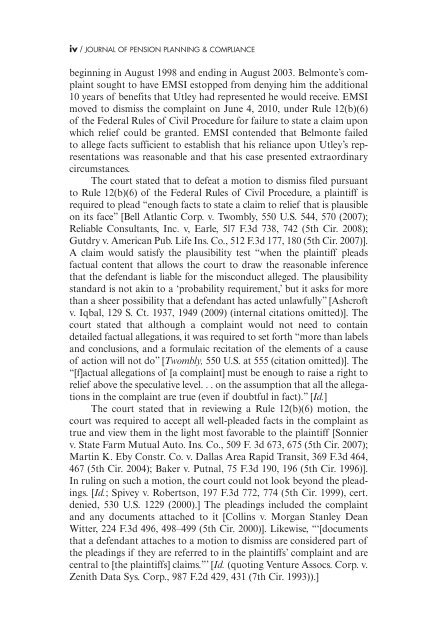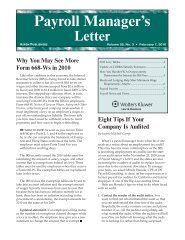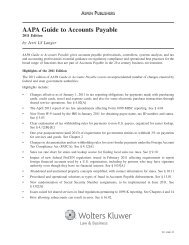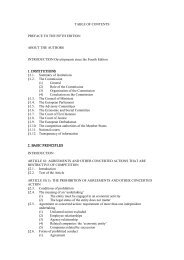journal of pension planning & compliance - Kluwer Law International
journal of pension planning & compliance - Kluwer Law International
journal of pension planning & compliance - Kluwer Law International
You also want an ePaper? Increase the reach of your titles
YUMPU automatically turns print PDFs into web optimized ePapers that Google loves.
iv / JOURNAL OF PENSION PLANNING & COMPLIANCE<br />
beginning in August 1998 and ending in August 2003. Belmonte’s complaint<br />
sought to have EMSI estopped from denying him the additional<br />
10 years <strong>of</strong> benefits that Utley had represented he would receive. EMSI<br />
moved to dismiss the complaint on June 4, 2010, under Rule 12(b)(6)<br />
<strong>of</strong> the Federal Rules <strong>of</strong> Civil Procedure for failure to state a claim upon<br />
which relief could be granted. EMSI contended that Belmonte failed<br />
to allege facts sufficient to establish that his reliance upon Utley’s representations<br />
was reasonable and that his case presented extraordinary<br />
circumstances.<br />
The court stated that to defeat a motion to dismiss filed pursuant<br />
to Rule 12(b)(6) <strong>of</strong> the Federal Rules <strong>of</strong> Civil Procedure, a plaintiff is<br />
required to plead “enough facts to state a claim to relief that is plausible<br />
on its face” [Bell Atlantic Corp. v. Twombly, 550 U.S. 544, 570 (2007);<br />
Reliable Consultants, Inc. v, Earle, 5l7 F.3d 738, 742 (5th Cir. 2008);<br />
Gutdry v. American Pub. Life Ins. Co., 512 F.3d 177, 180 (5th Cir. 2007)].<br />
A claim would satisfy the plausibility test “when the plaintiff pleads<br />
factual content that allows the court to draw the reasonable inference<br />
that the defendant is liable for the misconduct alleged. The plausibility<br />
standard is not akin to a ‘probability requirement,’ but it asks for more<br />
than a sheer possibility that a defendant has acted unlawfully” [Ashcr<strong>of</strong>t<br />
v. Iqbal, 129 S. Ct. 1937, 1949 (2009) (internal citations omitted)]. The<br />
court stated that although a complaint would not need to contain<br />
detailed factual allegations, it was required to set forth “more than labels<br />
and conclusions, and a formulaic recitation <strong>of</strong> the elements <strong>of</strong> a cause<br />
<strong>of</strong> action will not do” [ Twombly, 550 U.S. at 555 (citation omitted)]. The<br />
“[f]actual allegations <strong>of</strong> [a complaint] must be enough to raise a right to<br />
relief above the speculative level. . . on the assumption that all the allegations<br />
in the complaint are true (even if doubtful in fact).” [ Id. ]<br />
The court stated that in reviewing a Rule 12(b)(6) motion, the<br />
court was required to accept all well-pleaded facts in the complaint as<br />
true and view them in the light most favorable to the plaintiff [Sonnier<br />
v. State Farm Mutual Auto. Ins. Co., 509 F. 3d 673, 675 (5th Cir. 2007);<br />
Martin K. Eby Constr. Co. v. Dallas Area Rapid Transit, 369 F.3d 464,<br />
467 (5th Cir. 2004); Baker v. Putnal, 75 F.3d 190, 196 (5th Cir. 1996)].<br />
In ruling on such a motion, the court could not look beyond the pleadings.<br />
[ Id. ; Spivey v. Robertson, 197 F.3d 772, 774 (5th Cir. 1999), cert.<br />
denied, 530 U.S. 1229 (2000).] The pleadings included the complaint<br />
and any documents attached to it [Collins v. Morgan Stanley Dean<br />
Witter, 224 F.3d 496, 498–499 (5th Cir. 2000)]. Likewise, “‘[documents<br />
that a defendant attaches to a motion to dismiss are considered part <strong>of</strong><br />
the pleadings if they are referred to in the plaintiffs’ complaint and are<br />
central to [the plaintiffs] claims.”’ [ Id. (quoting Venture Assocs. Corp. v.<br />
Zenith Data Sys. Corp., 987 F.2d 429, 431 (7th Cir. 1993)).]






